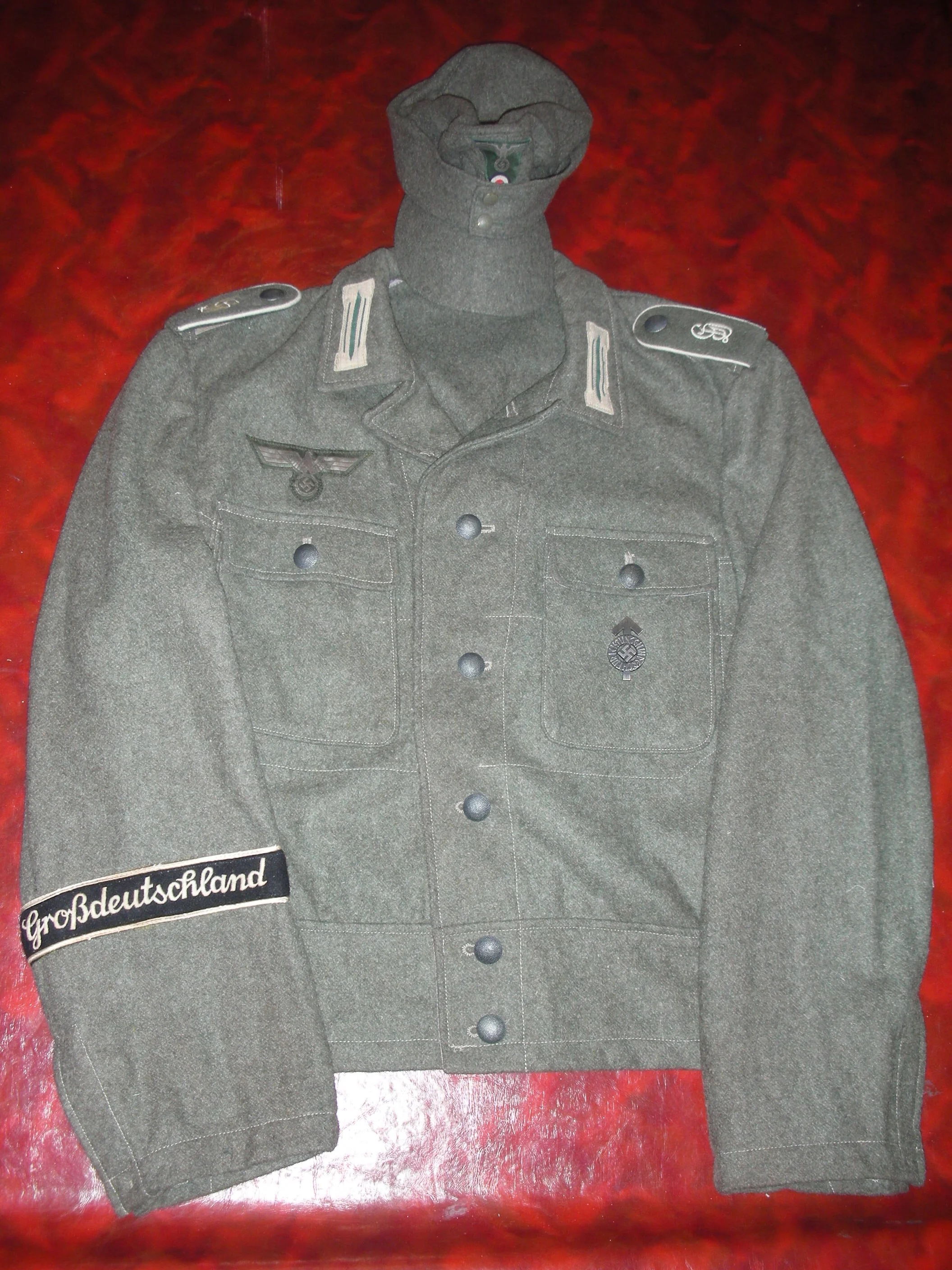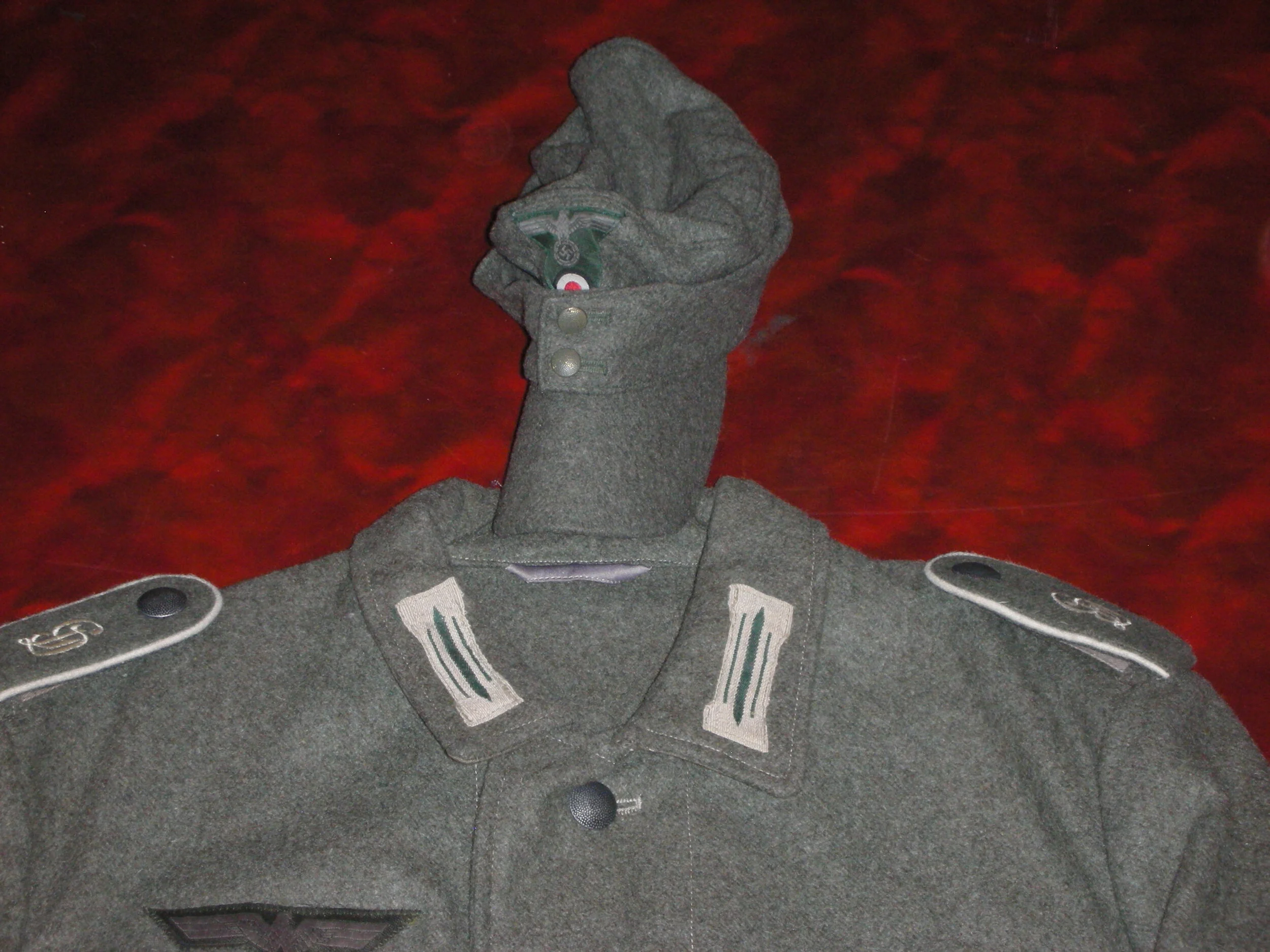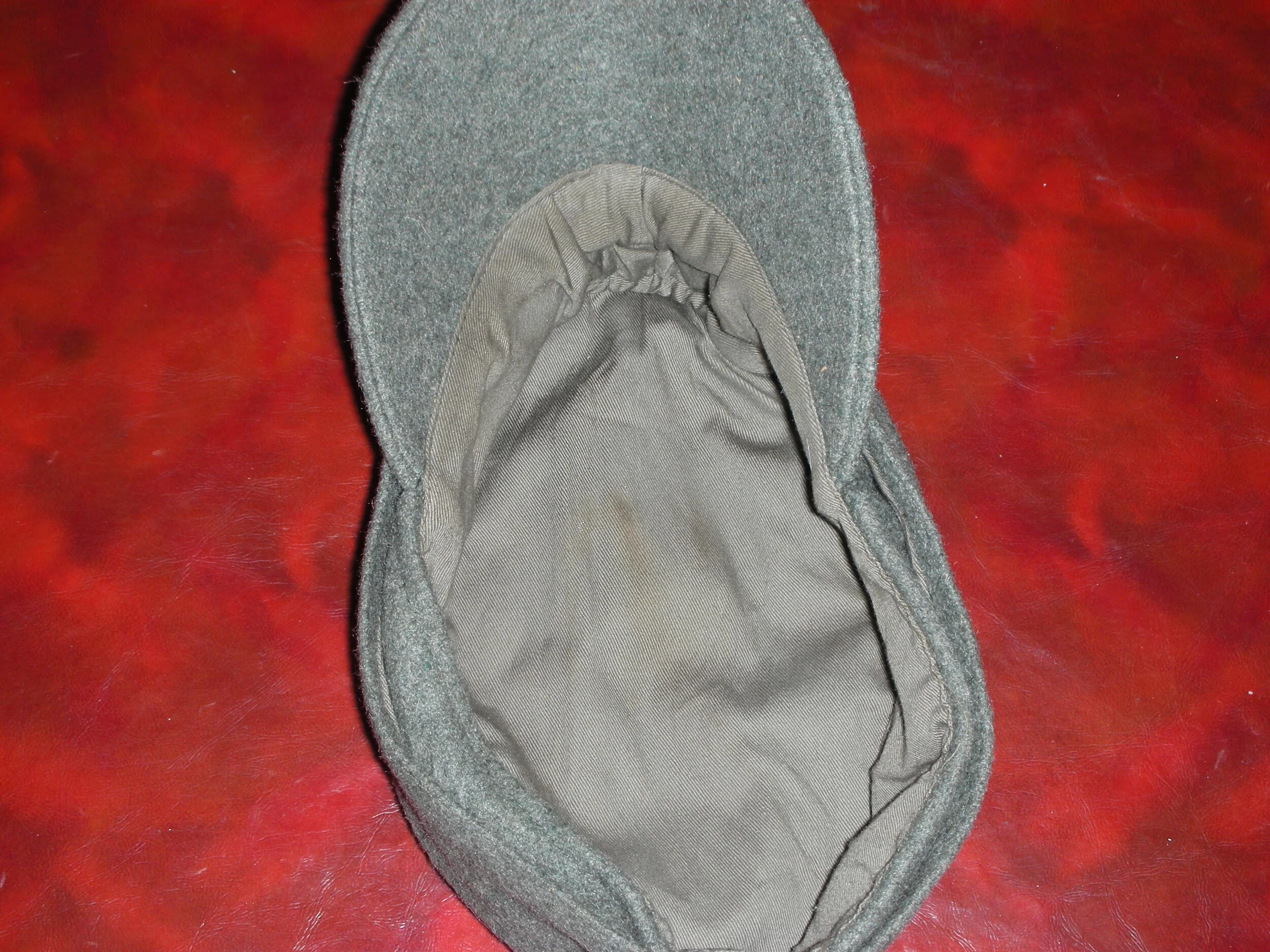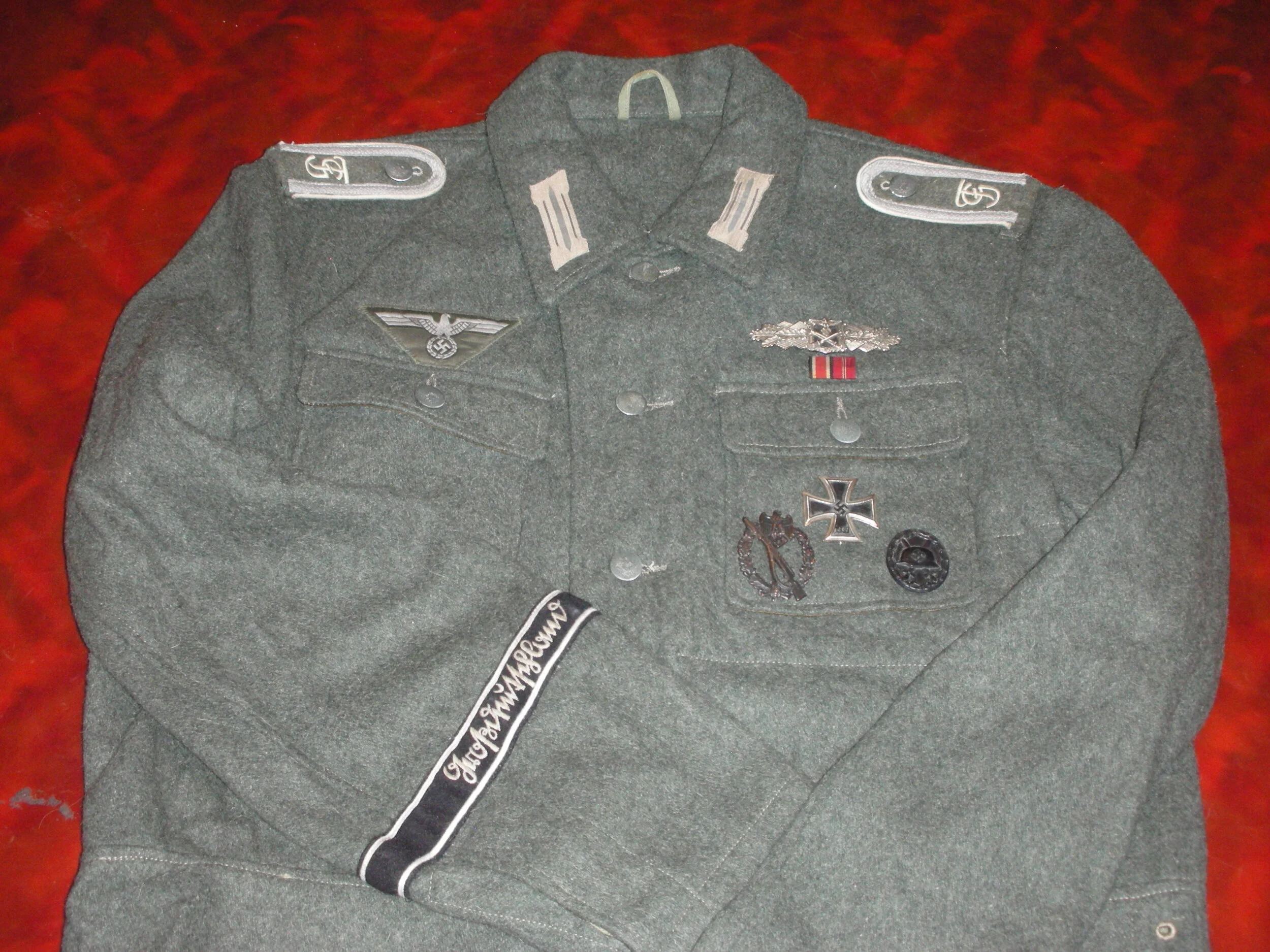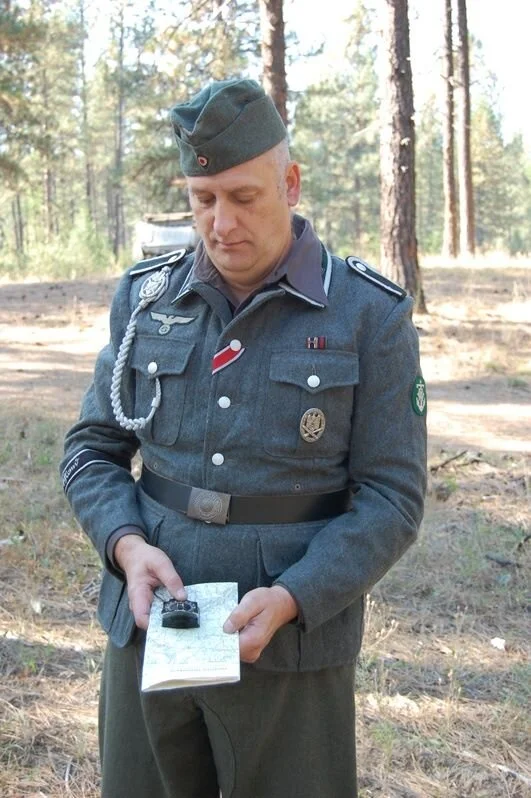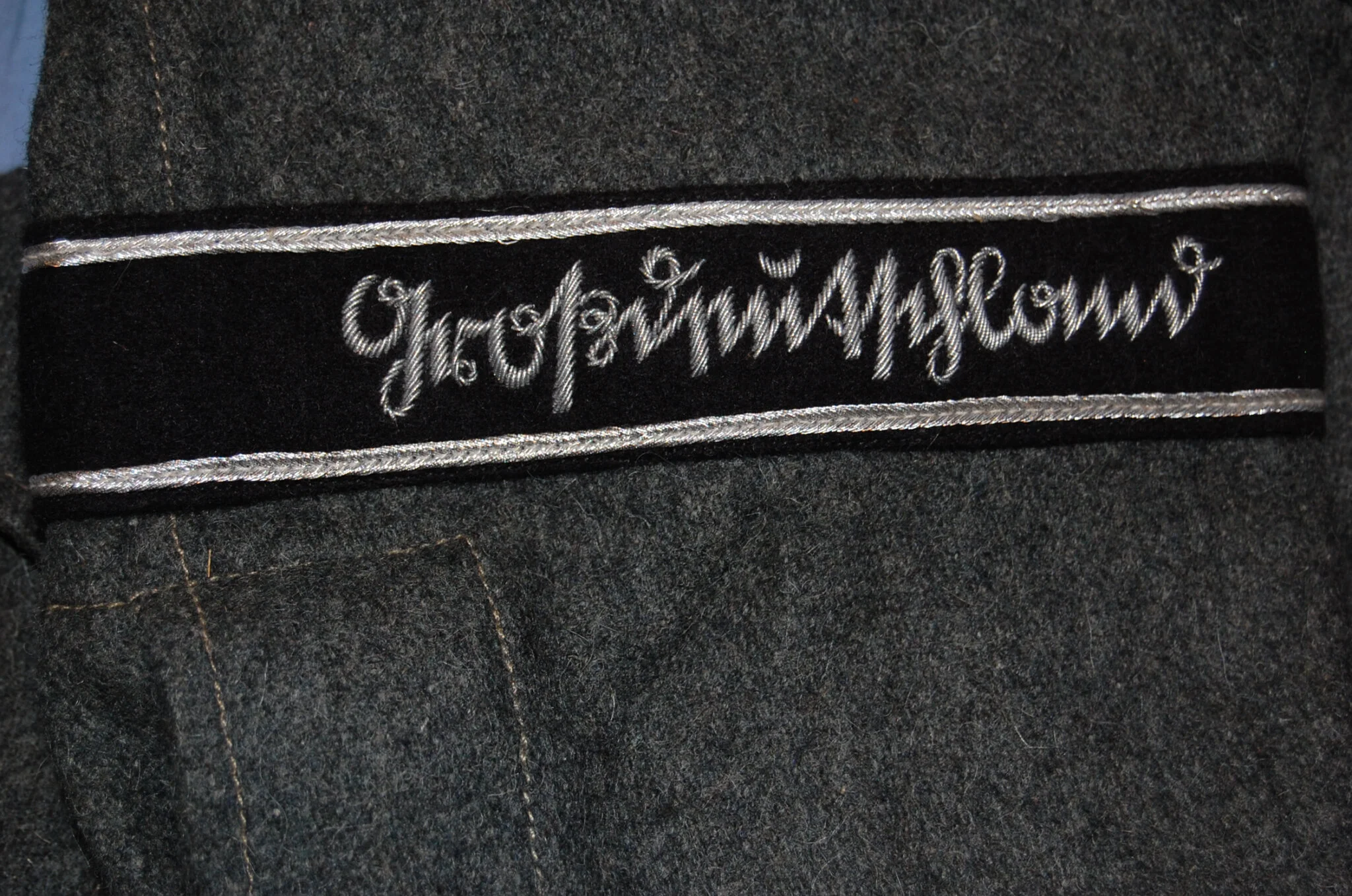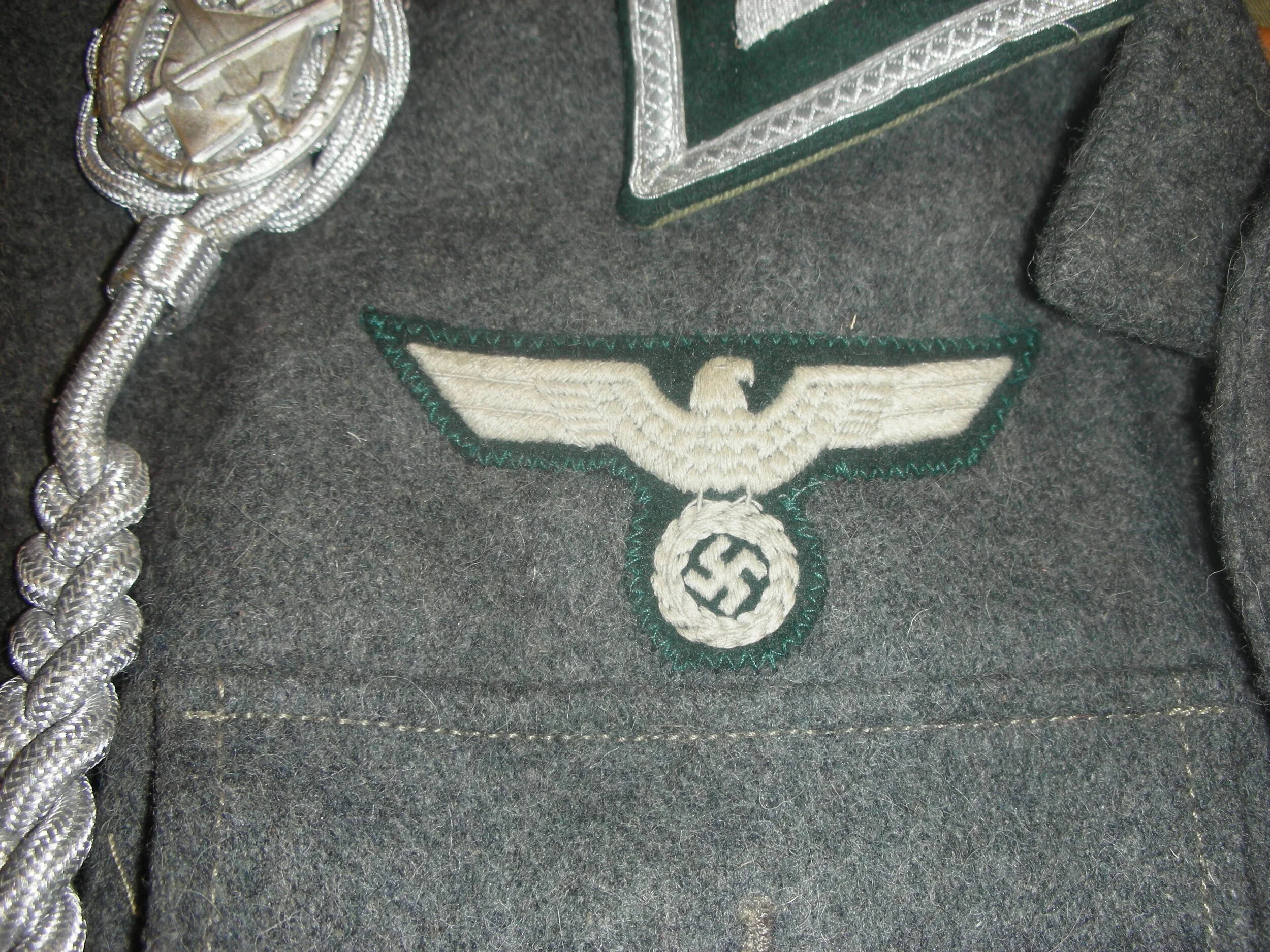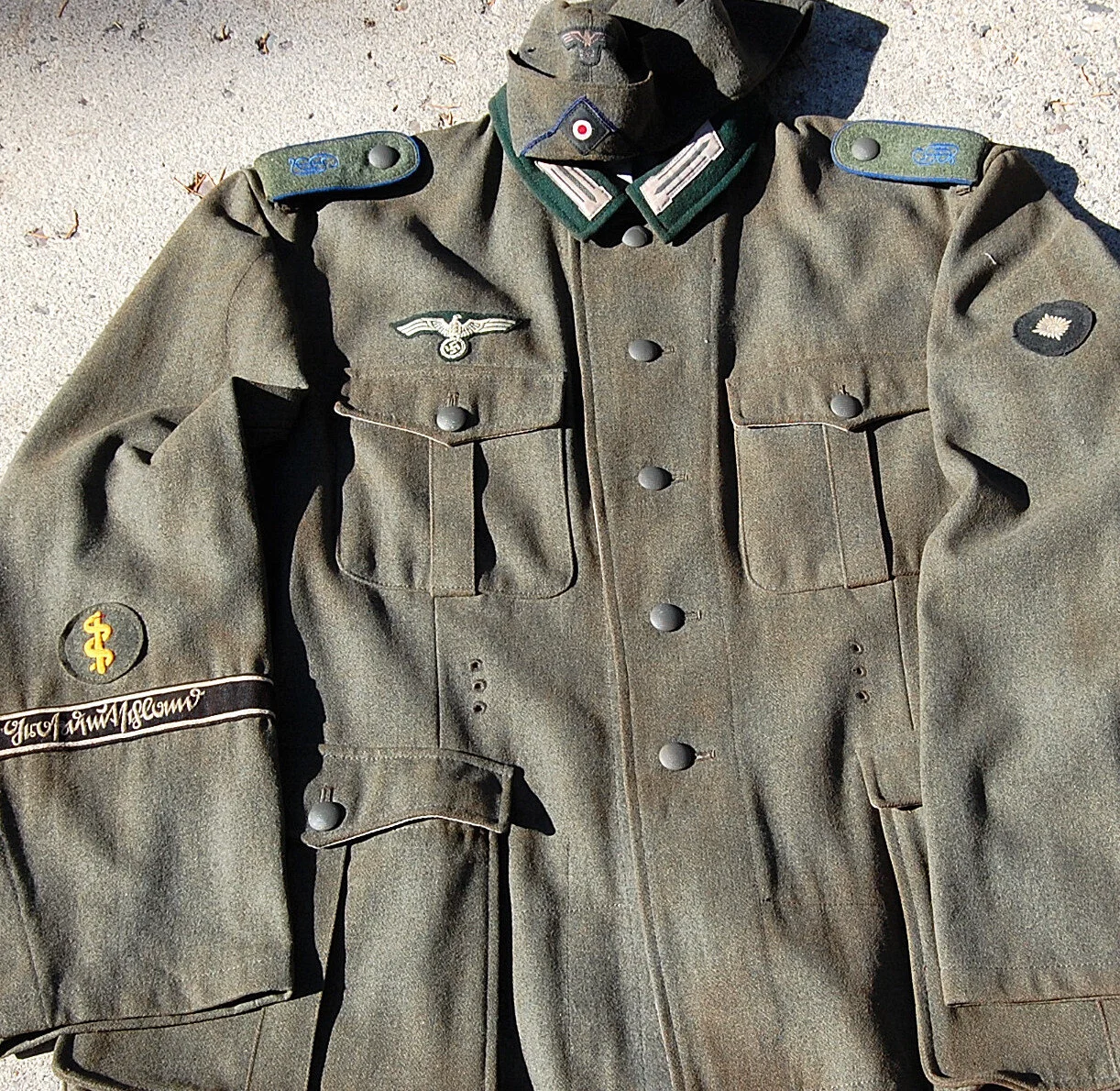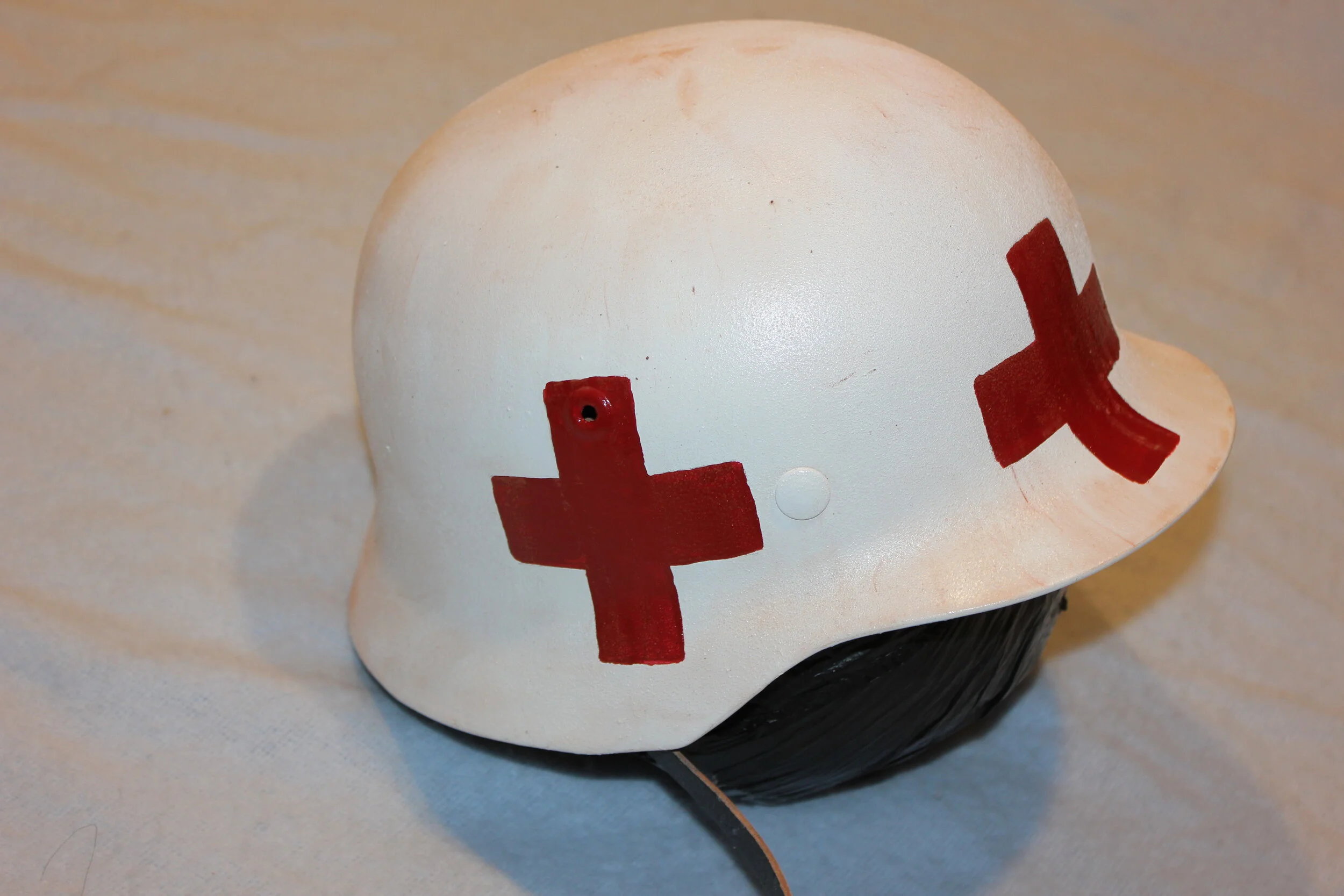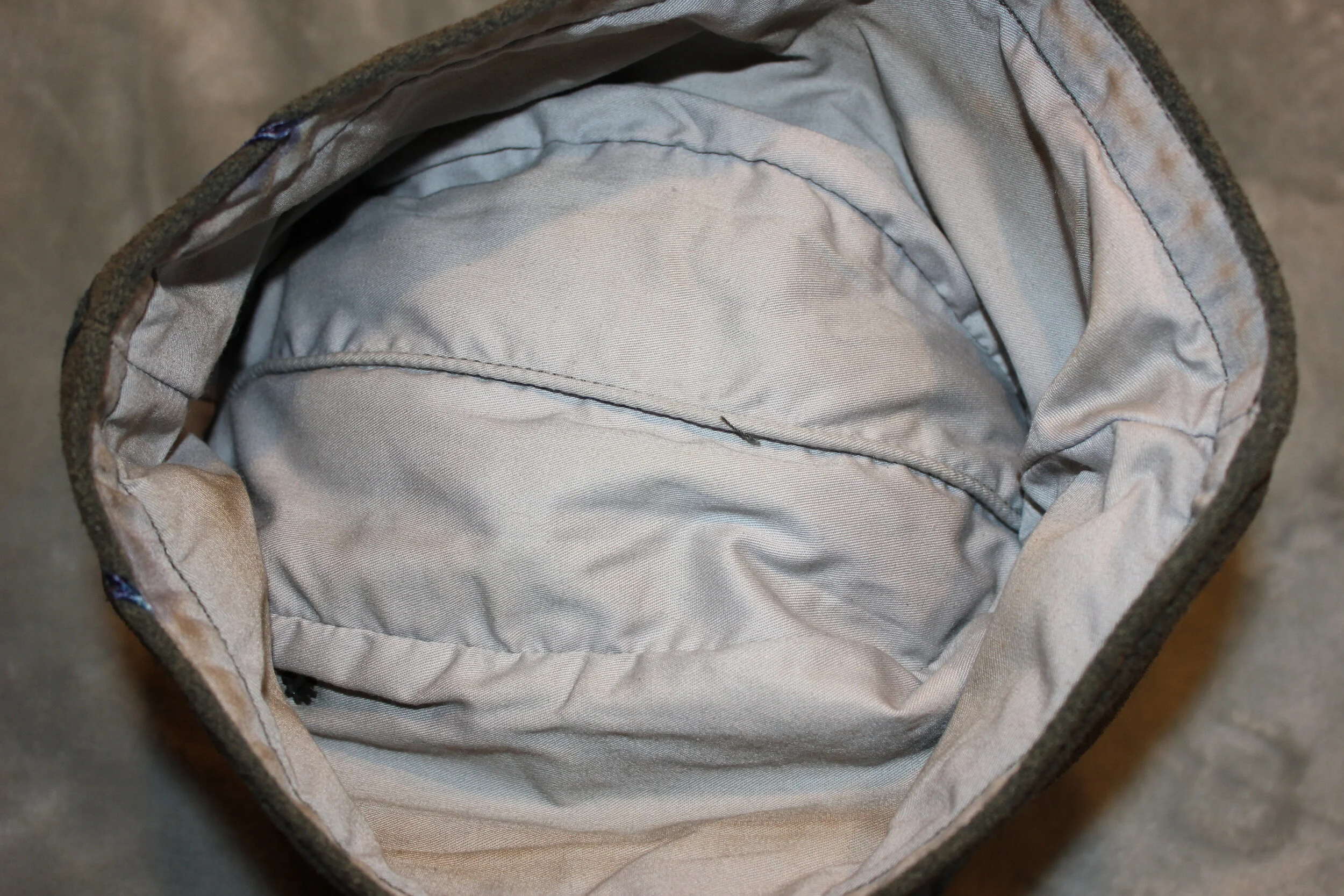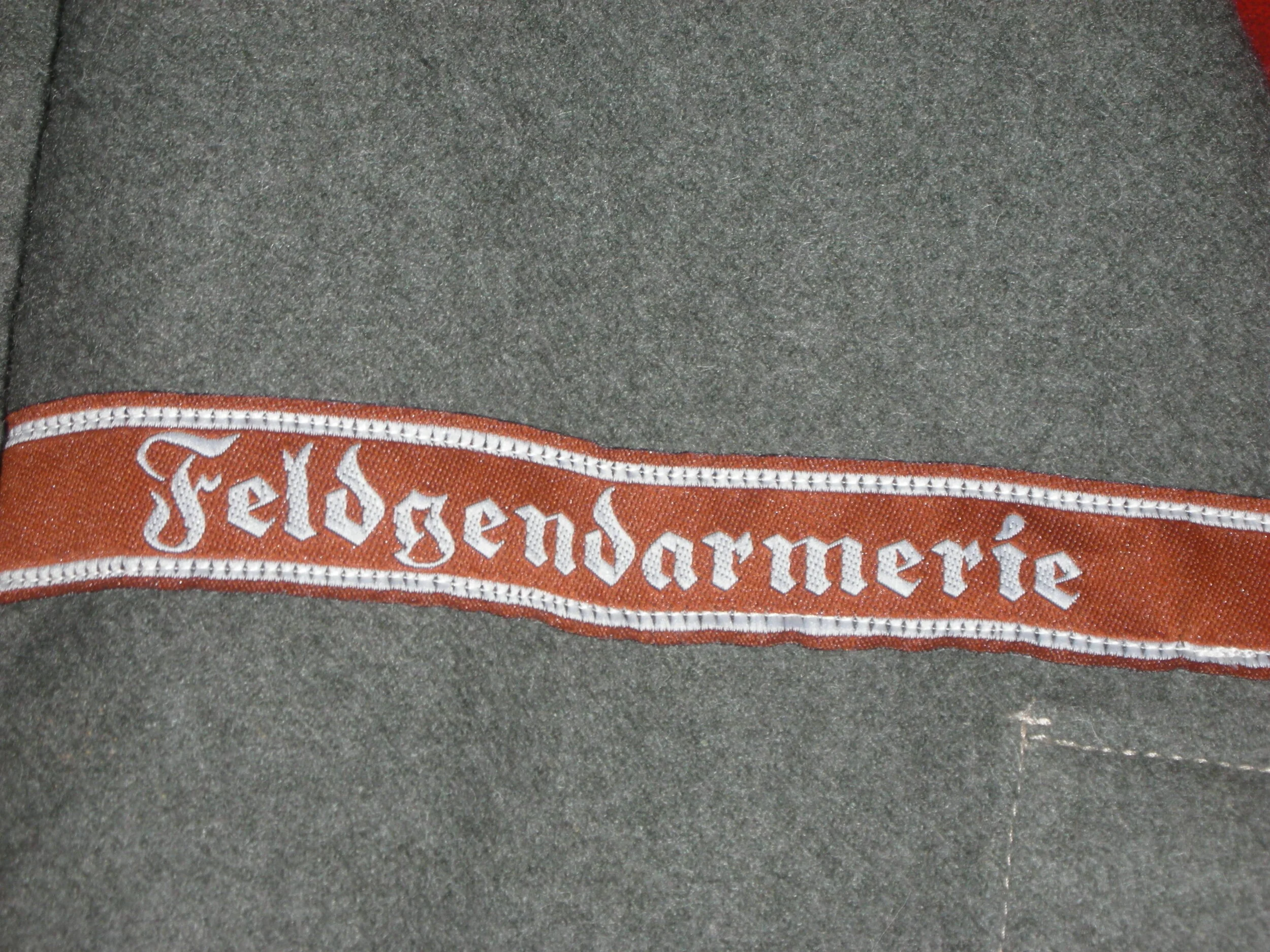Part #2, GrossDeutschland Battle Uniforms:
Uniform Shirt and Trousers:
We’ll get the story on the Grossdeutschland’s Infantry Regiments 1 u. 2. As we understand it, with the Grossdeutschland’s expansion to “Infantry-Division (mot)” status, a second infantry regiment was formed in Berlin and added to the divisional strength along with supporting Panzer and Sturmgeschütz battalions, along with additional Flak, Artillery, and Engineer support. The original infantry regiment was renamed Infanterie-Regiment “Grossdeutschland” 2. It was then that the introduction of shoulder boards with the white numerals 1 and 2 under the intertwined “GD” cipher took place, in April 1942. And a sort of “Rif” between them started there and then.
The veterans of “GD-1” had a very poor relationship with the new infantry regiment from the outset, and none of the cadre personnel of the existing Infanterie-Regiment “GD” were used to form the new organization. Little contact took place between the two units, and they were known to each other only by derogatory nicknames. When Oberst Lorenz left “GD” 1 to command the division, this rocky relationship deteriorated even more as he apparently paid no attention to “GD” 2, favoring his old unit, so they operated differently.
After reorganization, “Grossdeutschland” was assigned to the XLVIII Panzerkorps during the opening phases of Fall Blau, the assault on Stalingrad. The Division took part in successful attacks to cross the upper Don River and then captured Voronezh. In August, the division was pulled back to the North bank of the Donets and held as a mobile reserve and fire brigade counterattack force.
In October 1942 “GD” 1 was renamed “Grenadier Regiment” Grossdeutschland and “GD” 2 became the “Füsilier Regiment”; and with the Heereasmitteilung 43, Nr 466, they were ordered to remove the 1 and 2 numbers from their shoulder boards, so then was when white and red strings and strips of cloth started being seen on the shoulder boards, keeping them identified and in defiance. What does this have to do with this shirt and trousers…..nothing, the shirt, and trousers were shown so you can see what was worn under the controversial jackets, rather than the story being completely true. I don’t know, but there is usually some truth behind most stories.
These first three uniforms of the Grossdeutschland Division collection represent the division okay, but there was more we found out, and we dug up more and more of the story in the following uniform representations.
Grossdeutschland Enlisted Man, The Standard Uniform M36:
The M36 Field Tunic or Feldbluse along with the M40, M41, M42, M43, and M44 were all field tunics used by Wehrmacht was the “Military or Armed Forces”, it, like other world armies, was made up of the Army (Ground Forces), Naval Forces, and the “New” Air Force, they were known individually as the Heer, Kriegsmarine, and Luftwaffe. In theory, they could all use the same uniforms, if not different colors, while the Heer set the standard with battle and dress uniforms, in a basic 4-pocket cut, it tended to lean to the dress application.
When the Waffen SS adopted the uniform, they had their V-T cut, but some adapted the M36 because of low stock for the VT-cut available at the time of their expansion, and the Heer models were soon seen with the SS in battle, and popular as well with the troops.
The Heer model was made of wool, like all the services, and it had a greyish-green (Feldgrau) color, but the collar and shoulder boards as well as some of their other insignias, like the National Eagle, and Jager patch and the like were all backed in a so-called “Bottle-Green”, that was seen as a bright green at times but in general a dark feldgrau was used.
The Luftwaffe had to have their special cut uniform, and the color was officially a “Blaugrau”. The military as a whole used different model uniforms, i/e, the M26, 40-41, 43, and M44 styles. The Luftwaffe had for “Flyers” their Fligerbluse that was popular, and the Kriegsmarine used the 4-pocket for specific duties, but kept the traditional Naval “Jumper”. All had four pockets on the front, and five buttons to close the tunic, tell the M44 came along.
This would be the typical uniform seen early on during the war, while maybe better than that of the First World War, they were anything but practical. Wool was the standard for most ‘Armies of the World” of the time, unless in a tropical area or desert. Then there was cotton and linen, but the look seems to have been the important thing, the uniforms worked neither real well, nor were they practical for the battlefield, they were made to intimidate the civilians, with big shoulders and large open cuffs, to let the cold in, and hang up on things at the wrong time, tailored uniforms rather than baggy, disposable uniforms, a and other lessons were re-learned again like the realization, that large flashy collar patches and big flashy shoulder boards drew far too much attention from the enemy aiming at you from the other side!
Yet even with the M41, M42, and M43 decorations, and insignia were used far more than the Americans, who had no problem turning their jackets inside-out if need be. Some of the notable features of the M36 Heer Feldbluse included internal straps that helped hooks for carrying their basic bread bag, ammo, and various parts of their general “kit”, and helped with pack-loads. The stand-up and fall collar with a double “Hook” closure was slightly modified to be taller, so the larger black-rhomboid SS patch could be applied to it.
Oberfeldwebel, Karl Steinhous, 3. Kompanie Infanterie-Regiment “Grossdeutschland”, Gefallen in Frankreich, May 1940:
Having plenty of uniforms in this part of the collection to tell the Grossdeutschland’s story, I’ll take a moment and talk about the many patterns of uniforms that were seen in use with the regiment, and as it morphed into the division, it became. This uniform was one of the early and most commonly seen.
With the formation of the new Infantry-Regiment “Grossdeutschland” in 1939, the need for experienced senior non-commissioned officers was addressed by obtaining volunteers from Vehrkries III, the greater Berlin area. Three units were levied to provide both NCO and Enlisted soldiers for the new Regiment. The Wachtregiment provided security to the Berlin government and was reduced to company size while it filled the I. Battalion.
The Lehr Regiment was composed of the best German Infantry, all selected from trained troops and one of the first motorized units in the German army; its Infantry-Sturm-Lehr Bataillon formed the basis of the III. Bataillon. The 92. Infantry Regiment had fought in Poland and provided the battlefield experience, it’s II. Bataillon was transferred in its entirety, becoming the II. Bataillon of Infantry Regiment “Grossdeutschland”.
Operation “Fall Gelb”, the German codename for the planned attack against France and the Low Countries, had initially been very similar to the ‘Schlieffen Plan’, which had been used a generation before in 1914. However, the Allies had the plans fall into their possession after a German plane with an officer in it crashed in Belgium.
Hitler now needed a new plan that would take advantage of the supposed knowledge of Germany’s intentions. Using General von Manstein’s idea of a mechanized attack through the weakly held Allied center. German Forces attacked by occupied Luxembourg during the evening of 9 May. The following morning, Army Group B launched feint attacks against Belgium and the Netherlands. The Allied reaction was immediate! The British Expeditionary Forces (BEF) and the French units moved to Belgium and Holland to blunt the perceived German onslaught!
Infantry Regiment “Grossdeutschland” was placed in Panzergruppe Kleist. In Guderian’s corps, the regiment participated in the opening phases of the campaign, providing troops to a special air-landing operation in Belgium while the main body of the regiment passed through Luxembourg and also into Belgium. Crossing the Meuse and fighting at Stonne, the regiment acquitted itself well. After a six-week conquest of France, it seemed that peace would come in 1941.
The regiment ended the campaign at Lyons, having lost 1,200 men during the campaign, 1/4 of its strength. It was sent to Colmar for rest and refitting, and from there to Belfort, where it trained for use in either Operation Felix, the Invasion of Gibraltar, or Operation Sea Lion, the Invasion of England.
*This NCO is one of the 41 NCOs killed in action during the campaign. Oberfeldwebel Steinhous fell on 16 May 1940, in the battle near Stonne, and the family was notified of their loss. Following Hitler’s decree, they received his personal belongings from the Kaserne with his posthumous decorations.
The Feldbluse, broken Erkennungsmarken, decorations, and paperwork were all left in the box and placed in storage in the attic of their old home. in Aufenau near Bad Orb in Hessen. The notification of his death went to the family, and the uniforms and belongings were sent to his Mother or Wife to be kept by them.
Note that, the photos I have were taken in a spur-of-moment photoshoot, and it is depicted on the Russian Front, these “photoshoots” always catch me off guard, and nothing is planned out, and I botched this one sort of, but GD fought in Russia too, so, the uniform itself is does fit with the 1941-42 period of the invasion. Being an early style uniform, the M43 cap may not fit well here either, though there were still M36 uniforms being used.
Obergefreiter, Jager-Regiment 1, Grossdeutschland:
This Obergefreiter uniform is the standard-issue early-war Bluse known to collectors as the M40 Feldbluse. The same pattern as the Pre-War M36 Feldbluse, the war-issue uniform discontinued the dark green collar. It came from the maker with “War-Pattern” Litzen and the National insignia sewn already. Common practice as soldiers replaced the old tried M36 uniforms with new ones was to keep the old back-turned collar Litzen (with Infantry-White “Waffenfarben” on them) and keep the old pattern National insignia with white in as well, rather than the new duller look. That is the case here as well.
Interestingly, the Obergefreiter’s chevrons on the sleeve are the War pattern. he is indicatingthat an old uniform’s insignia is in use when he received his promotion. The feldgrau-backed rank and shoulder boards replaced the darker-green backing by 1942. In addition to the extremely rare “GD-1” shoulder board insignia, he also sports the 1st pattern “Grossdeutschland”, BEVO woven-Cuff Title.
He has proven his leadership in combat, Eiserne Kreuz II. Klasse, and has been wounded in battle at least once, wearing the Verwundenabzeichen in Schwarz.
Note, in the first couple of pictures, some of us got together and tried to get some-semi-realistic pictures, for a book idea I had been kicking around, we took pictures of other uniforms as group shots too, and eventually, books were made, and some of the pictures used in them, everything has changed since the pictures were taken, glad we did it though, and they were taken over several locations, and 3 shoots, Ive only ever don 3-4 photoshoots so to speak, ther’re more interesting to show the uniform, but you have to lay them out on the floor to see them right.
“NEW” Schutz, 2./Panzer-Grenadier-Regiment G.D. :
In the fall of 1942, the Oberkommando des Heeres directed the adoption of the title Grenadier by all Infanterie units. Großdeutschland re named Infanterie Regiment G.D. 1 to Grenadier-Regiment Großdeutschland and Infanterie-Regiment G.D. 2 became Fusilier-Regiment Großdeutschland.
The Sonderbekleidung für Panzergrenadier began to be issued to both units in 1943. They were light and popular wear with the Grenadiers, and the final pattern of Ärmelstreifen dates this uniform to 1944 or later. Early pattern Litzen stitched on dark green badge cloth appears in several period photos, an oddity for the time; perhaps using division stores. Wearing either a sweater or shirt and tie seems common, as does the mix of the armored uniform with standard four-pocket Bluse in the period photo of a Kompanie commander briefing. The majority wear the Eineheitzfeldmütz along with the Stahlhelm und Feldmütz für Offizier.
Oberfeldwebel, Karl Schwappacher, Zugfuhrer, Panzer-Grenadier-Regiment “Grossdeutschland”:
Oberfeldwebel, Karl Schwappacher was a Zugfuhrer in the 13,IG (Infantrie-Geschutz) K.p./ Pz.Gr.Rgt. “Grossdeutschland” during the fighting in Romania in the Spring of 1944. “Schwapp,” as he was known to one and all of the Regiment, was another of the indispensable veterans of the Infantrieheerregiment Dobertz, where he had been a Gunnery Instructor on the IG.33 IR (motorized) “GD” in late 1933.
A native of Bavaria, Karl Schwappacher served throughout the war with the “Grossdeutschland”, participated in every one of its campaigns, and was decorated with the “Deutsche Kreuz in Gold”, Ehrenblatt des Deutschen Heers*, Allgemeines Sturmabzeichen II, and Verwundeten-Abzeichen in Silber.
Despite all the action he saw in Russia, Karl Schwappacher recalls the crossing of the Meuse at Sedan and the intense fighting at Stonne in May 1940 as the most memorable of his experiences with “Grossdeutschland”.
At the base of his shoulder boards, Oberfeldfebel Schwappacher wears the standard white cloth strip (in this case twine) which distinguished the Pz. Gr.Rgt. “GD” from the Pz.Fus.Rgt. “GD,” who wore a Res strip.
Schwappacher wears the standard Heer “Sturmgesshutz” uniform with white Waffenfarben Soutache sewn around the Collar Litzen mounted on panzer-style backing. He has metal divisional ciphers on his shoulder insignia. The standard BEVO style Heer National Eagle insignia has been replaced by a custom embroidered version just above Deutsche Kreuz in Gold.
The black chord holds his command whistle. In period photos, Oberfeldfebel Schwappacher wears the Einheitsfeldmutz 43, with mosquito netting over it, but in battle, he likely wore a standard Stahlhelm.
Grenadier, Grenadier-Regiment of Panzer-Grenadier Division “Grossdeutschland”:
This young Panzer-Grenadier uniform is as it would be when he was getting ready for a training graduation portrait picture, assigned to the “GD” he has not left for the front yet. So, the uniform is in a “Walking-Out” form.
It would be quite possible he was one of the “GD” members who were issued to try the new “M-1944 Uniform” (there are pictures of the war with the non-standardized insignia-leading to the assumption that it was introduced to the troops to try them out before issuing to the field troops.
The uniform’s issue-shoulder boards, naturally, are the late-type style, having a white GD cipher nicely sewn directly on them, with white thread, as is the board’s piping. While called “Grenadiers,” they all were motorized infantry; the “Panzer Grenadier Green piping was not used by the GD, not even the Panzer-Grenadiers. The “Grossdeutschland” Troops also identified their regiment as well (to stand out) using various available materials, white bands of material over the bottom of the boards indicating the 1st regiment.
The Grenadier wears the Hitlerjugend Proficiency Badge, indicating he has completed training but has not yet been sent to the front (where this would disappear). He has the final version of the Grossdeutschland Division’s cuff title on the cuff.
The walking-out uniform is completed with the M43 wool cap, with the traditional “pinched crown”, from pinching the front when taking the cap off and putting it on. The German Army trained the troops never to touch the “bill” of their schirmmutz (dress cap), so they didn’t smudge the shiny Vulcanized-fiber bill with fingerprints, so they just started doing it with all their hats.
He wears the M44 issue jacket and trousers, designed with belt loops, a first for the German soldier. The standard black belt with enlisted belt buckle has been stripped of the uniform for the photo shoot. He likely would have had his short boots all polished up as well, with the cuff of the pants over the shoes rather than bloused up. These trousers were the first type to have a drawstring at the bottom to do so with. The gloves were given to him, one should think, for the picture shoot by a ranking friend, as they are an “Officers Walking-Out Dress” item, and not seen with the soldiers.
Unteroffizer, "Fuhrer Grenadier Division":
This seasoned Grossdeutschland veteran is now a cadre for this late-formed part of Panzerkorps Grossdeutschland. Formed in early 1945 and commanded by Major General Hellmuth Mader, FG fought in the Army Group Vistula and ended the war fighting for Vienna as part of Dietrich’s 6 1h SS Panzer Army. The Unteroffizier wears a recently issued M44-Field Service Uniform with the shortened Feldbluse, belted trousers, and the M43 cap. His affiliation with Grossdeutschland is identified by his cuff title, probably removed from his worn-out previous field uniform.
The “Fuhrer Grenadier Division” is noted on the ciphered shoulder boards, a rare addition. He had been fighting with Grossdeutschland since the start, where he served during the first Russian winter. This troop has been awarded both Iron Crosses. His combat time is shown by the Infantry Assault Badge in Bronze given to Armored Infantry and his Silver Close Combat Clasp. He has been wounded at least once and has hung the Black-Wound Badge on his jacket.
Obergefreiter, Infantry Division "Grossdeutschland", re-issue (HBT) “Reed-Green” Dyed Dungarees:
Recruits and soldiers had traditionally worn the Drillishanzug (Fatigue Uniform) on work details, weapons cleaning, and other lie duties likely to get soil on the wool uniform, A simply patterned jacket, it was an un-lined, insignia-less uniform made of hard-wearing linen herring-bone pattern material that produced the standard work clothing for both military and civilian use.
The jacket had just two buttonless pockets on the skirt, and normally a stand-and-fall collar. The fatigue uniform originally was not even dyed, it the keep it real simple concept, the raw color of the flax that produced the linen was off-white. It wasn’t till 12 February 1940 that the color of the fatigue was ordered to be Reed-Green(Blueish-Green).
As the Wehrmacht combat forces started their assault across Europe, the heavy, uncomfortable wool uniform started to hinder their performance, especially in the Summer months. The use of the now green, lightweight uniform was quickly adopted by the troops. And while the regulations restricted the use of insignia on the uniform, soon the uniforms were being issued (at battalion level) with the National Eagle and collar tabs already sewn in place, with loops for shoulder boards, so they were added if not already in place.
By 1942, this appears to be pretty common practice, and it was regularized for the same reason battle dress has insignia for quick recognition. At this time, it was decided that an official “Hot-Weather” four-pocket uniform of the HBT material in the Feldbluse cut would be authorized to the troops, and they started to fill the ranks as older clothing got worn out, ripped up, or just too hot.
Photos show the Infantry Regiment “Grossdeutschland” wearing the Drillichanzug in the field with full insignia. The Obergefreiter’s bluse has had its original dark green hand-stitched shoulder boards and sleeve rank insignia applied to it. No divisional cuff title is worn with the jacket, though, but the evidence shows on the early forms of the uniform. He wears the standard M37 trousers cut from the same material. The Drillichanzug is strictly a field uniform, not worn behind the front-line area. The Obergefreiter wears what was probably a field-made (HBT) cap, based on the old Afrika-Korps M40, and those being used by the Waffen-SS, a precursor to the M43 Einheitsfeldmutz. The standard field gear was worn over the uniform, along with Marchstirfel (Boots).
Unteroffizier, “Grossdeutschland”, Regiment (Rgt.1), (Modified Summer “HBT”M43 cut Uniform):
Infantry Unteroffizier, from the ‘Fusilier’ Regiment of Panzer Division "Grossdeutschland" wears a custom example of the popular “Summer HBT Uniform”, in Russia, where it was worn by those who could have one made, usually by a local tailor. A combat uniform, it is cut in the early war period style M-36 look, with pleated pockets, and has a dark green collar attached.
His rank is shown by the shoulder insignia, and collar with the open-end tress being indicative of Unteroffizier or Sergeant. The GD divisional cipher is stitched into shoulder boards, that are in an unusual bright green color, piped in infantry white. (In some pictures, I had a white loop on the shoulder boards; this was a Grenadier Regimental item, but the “Füsilier-Regiment” had a Red loop.) So I’m going with the story that he got a promotion and was moved to the 1st Regiment.
Anyway, this NCO has been with the division since at least the invasion of Russia, as shown by the ribbon in his buttonhole. He has seen significant combat and has proven his leadership by winning both the Iron Cross II Class (shown by the ribbon through the button-hole) and I Class worn on the pocket.
Receiving the Black Wound Badge, he has been wounded at least once and maybe up to three times and wears the Infantry Assault Badge hanging from the pocket, the Close Combat Clasp in Bronze, and two Tank Destruction Badges on his right sleeve (the Tank Destruction Badge awarded for the single hand destruction of an enemy tank with a handheld weapon such as mine (not with an antitank weapon). On his right sleeve is the third pattern of the GD divisional cuff title.
The uniform even carries its belt hooks, woven through its internal suspenders, and he’s kept his dressing pocket with the bandage in there- when you need it-you need it! When not in combat. and wearing a Stahlhelm with a splinter pattern cover on it. He wears an HBT pattern field cap. He wears the standard-issue reed-green trousers in the summer’s heat.
Ritterkreuz u. Ehenblatt des Deutschen Heerestrager, Major Alfred Greim II. Infantry-Regiment G.D.1
Alfred Greim joined the Reichswehr in 1922, completed officer training, and was promoted to Leutnant with Infanterie-Regiment 15 in 1925. In 1933, he was transferred to the Infanterie Erzatz u. Ausbildung Regiment in Döberitz and from there to Infanterie-Regiment Großdeutschand in 1939 and took part in the Battle of France as commander of the II. Bataillon earning both the EKI. u. EKII. Greim also led the II. Bataillon at the beginning of Operation Barbarossa was awarded the Deutsche Kreuz in Gold on 20 October 1941. During the fighting in the winter of 1941/42 in the bridgehead on the Oka near Bedrinzy-Woronez, Greim led counterattacks that threw back Russian forces that had broken through German lines. For his leadership he was awarded the Rit terkreuz der Eisernes Kreuz in 4 Juni 1942. His name was also recorded in the Heeres Verordnungsblatt, which resulted in the award of Ehrenblatt des Deutschen Heeres.
The Regiment later moved to Orel after, and on 1 April 1942, arising out of the need for new motorized formations for the summer off" it became “Infan tire-Division Großdeutschland". The existing Infanterie-Regiment became Infanterie-Regiment Großdeutschland 1 and was joined by a newly formed “Infanterie-Regiment Großdeutschland 2” along with a Panzer, Sturmgeschutz, Flak, Artillerie u. Pioneer Bataillons. The division was made part of the XLVIII. Panzerkorps for Operation Fall Blau, the assault on Stalingrad. The division took part in the successful attacks to cross the upper Don River and to capture Voronezh. In August, the division was pulled back to the north bank of the Donets and held as a mobile reserve counterattack force.
During the combined Soviet winter offensives, Infanterie Division Großdeutschland was involved in heavy winter fighting near Rzhev and earned the nickname Feurwehr. Heavy losses in the Rzhev salient made the division's combat ineffective. It was pulled out of the lines and yet again refitted and reorganized as Panzer-Division Großdeutschland. The Unteroffizier has modified the more comfortable prewar cut HBT reed-green fatigue Bluse for wear as his summer service uniform by adding standard insignia from a worn-out Feldbluse. This was a common practice until the introduction of the four-pocket Bluse as shown by a similar modification in another collection.
Oberschütze, “Großdeutschland” Füsilier~Regiment 2:
This Oberschutz uniform is another rare example of the initial changes in uniform construction techniques that would become known to collectors as the M43 Feldbluse. This Feldbluse displays the new 6-button front closure, as well as unpleated pockets.
The interior lining is modified with straps sewn directly to the interior for use with the uniform’s cartage belt hooks, part of the uniform, rather than two individual suspenders, crossed in the back and over the shoulders, with the hooks inserted through holes provided in the lining of the jacket in 4 places.
This early version, referred to as the M42 Feldbluse, retains the scalloped pocket flaps. The “Heer” National Eagle and collar Litzen was applied at the factory. The uniform’s fabric is made from a higher combination of Rayon and Recycled Wool, but it is not as robust as the earlier uniform cloth. The Oberschutz has applied the third pattern, “Sutterlin” Divisional Cuff Title to the uniform and the “Pip” or star rank to the shoulder board. He has earned the Eiserne Kreuz II. Klasse. As an Infantrie Soldier, he earned the Infanterie-Sturmabzeichen in Bronze.
Gefreiter, Panzer-Fusilier-Regiment G.D.
In the fall of 1942, the Oberkommando des Heeres directed the adoption of the title Grenadier by all Infanterie units. Großdeutschland renamed Infanterie-Regiment G.D. 1 to Grenadier-Regiment Großdeutschland and Infanterie-Regiment G.D. 2 became Fusilier Regiment Großdeutschland. Both regiments retained Weiss Waffenfarbe until the end of the war and used Weiss u. rote bands or cords for distinction. The Gefreiter wears the Heeres Dienstanzuge Model 1942. The first pattern, Ärmellstreifen, while not standard at this point in the war, was used when supplies were in demand.
“Photo-Updated” Unteroffizier, Panzer-Füsilier Regiment, Panzergrenadier Division “Großdeutschland”:
The Panzer-Füsilier Regiment was the second infantry regiment that had been added to “Großdeutschland” when it became a “Motorized Infantry Division” in the Summer of 1942, then known as “IR2” or more commonly “GD2”. Renamed “Füsilier” shortly thereafter, the division’s original infantry regiment reclaimed its “Grenadier” title. At this time, the Regiment was identified by a red piece of string around the lower end of the shoulder board. It is interesting that in this case, the troop had obtained a strip of Iron Cross ribbon material and rolled it up with the red showing for the purpose.
In 1943, the division was given “Panzergenadier” status with the first four companies of each of the regiments being equipped with the Sd.Kfz-250 and 251 Armored “Semi-Tracked” vehicles, much like the US. M2/M3 Half Tracks, becoming “Panzer-Füsiliere”.
This Unteroffizier most likely came to the division as part of the new “Motorized-Division” organizational increase in size. As his combat experience increased so has his rank, now an “Infantry Squad Leader”.
He wears the I u. II Eiserne Kreuz as well as the Infantrie-Sturmabzeichen in Silber. Normally, a Panzergrenadier would wear a Bronze Infantry Assault Badge, so this indicates he earned it before he arrived in 1942. Wounded in combat, possibly at Kursk, he has been awarded the Verwundetenabzeichen in Schwarz.
The mid-war pattern Feldbluse, known to collectors as the Model M43, has lost the pleated pockets with scalloped flaps of the earlier models. The Unteroffizier has used the extra EK-II Award ribbon, rolled it up, and used it over his shoulder boards to denote his alliance with the Füsiliere Regiment. The boards have hand-embroidered white “GD” ciphers, making them a bit rare.
His cuff title is the enlisted, thread version of the 4th pattern, which began being seen in 1943. With the bluse, he would wear a Stahlhelm likely with the “Heer” Splinter Pattern cloth Smock over it. When the helmet was not heeded, he had an M43 Feldmutz along with the mid-war “Kielhosen”, and short ankle boots with Gamaschen. When in combat, he wore the standard kit, bread bag, flask, and fighting knife or bayonet, they often kept their folding shovel in their belt to be used as a weapon.
Under the belt or in the boot would be a few Stick Grenades. The Cartridge Pouches or Magazine Pouches would depend on whether he was carrying the K98 Rifle or the MP-40 Submachine Gun. This is a near-textbook uniform.
Oberleutnant, D.R. Zugel, I. Battalion, Fusilier Regiment “GD”:
This unusual custom splinter camouflaged four-pocket jacket with a win-breaker style, lightweight coat with button cuffs. I have seen photos of him with Major von Basse and noted he wore the 3rd pattern cuff title on the uniform. I have not been able to find out much about Mr. Zugel; what happened to him is a mystery. He is reported to have won the German Cross in Gold in November 1944, as commander of the 1st Battalion of the Regiment. He does not seem to wear any decorations on his battle uniform (logically so), but one can assume the general assault badge(s) and EK-I and II. Klasse, and perhaps others as well.
This is one of those uniforms I just had to show, rare, but not completely unusual, it is often attributed to use with Panzergrenadiers, but not necessarily so. It is a matter of who can afford and has the time to have the custom uniform made. Company tailors are for patches and buttons, and mending holes, and something like this takes a little time. In the real photo, he wears the Schweremutz/Crusher, in one of our photoshoots (always rushed) we show the uniform with an M43 cap, there isn’t any photo evidence I have yet of that the case, but it fits, and could represent a different Oberleutnant, as with the helmet, just fits.
*Oberstleutnant, Hans-Dieter von Basse, Commander of the Fuhrer Panzer-Fusiliers Regiment, “Grossdeutschland”:
Hans-Dieter von Basse joined the new German / Heer as part of Infanterie-Regiment 47 on 20 October 1936. After becoming an instructor in Kriegschule-Dresden, he was transferred to Infantry Regiment 51, where he served as a Zugführer (Platoon Leader) for the Battle of France. On January 22, 1943, he became Kompaniechef (Company Commander) in the Fusilier-Regiment “Grossdeutschland”.
After being promoted to Major, on February 20, 1944, commanded the SPW or Armored battalion of the regiment. In fierce fighting against the Soviet troops in Vilkaviskis (Latvia) dated August 12, 1944, along with his battalion, Basse desperately defended a vital bridgehead against superior Red Army forces that sought to split Heer’s Group Nord and Mitte.
For his leadership in the unflinching defense of the battalion, Regiment Commander Horst Niemack proudly dubbed them the “Löwen~Batallion” (Lion-Battalion) and recommended the commanders be awarded the Knight’s Cross to the Iron Cross.
Von Basse was awarded the “Ritterkreuz des Eisernen Kreuz” on 10 September 1944 as Major and Kommander I. Batalilon / Panzer-Fusilier Regiment “Grossdeutschland” along with Unteroffizier Hans Roeger from the I. Kompanie. In December, von Basse was appointed regimental commander, which was followed by his appointment as Kommandeur Panzertruppenschule Bergen und Regimentsführer and he and most of his men fell in the final battle at Bahnhof Godnicken (Samland) on 16 April 1945.
Oberstleutnant Hans-Dieter von Basse was awarded the Eisernes Kreuz II. Klasse, Infantrie-Sturmabzeichen in Silber, Eisernes Kreuz I. Klasse, Medaille Winter-schlacht i’m Osten, Nahkampfspange in Silber, and the Deutsches Kreuz in Gold.
The Panzer uniform story: During the fighting for Festung Konigsberg, von Basse discovered a clothing storage depot that contained a large stock of Panzer uniforms. Von Basse ordered a trusted Ritterkreuztrager Feldwebel Hans Röger to requisition a supply of these for the regimental Stabskompanie personnel.
Regimental tailors attached standard infantry insignia to black uniforms. The existing photos of von Basse in the uniform show him still in major rank. Before he died in combat, von Basse was promoted to Oberstleutnant and was assigned to the Panzertruppenschule at Bergen.
The Panzertruppenschule or Panzer Training School Bergen was established when the school at Wunsdorf was moved in 1943 as part of the decentralization, of training areas around Berlin. A military training camp had been established at Bergen-Belsen in the mid-1930s. Located north of Munster, where there was also held a Political Konzentrationslager, aka “Concentration Camp”. The official Panzerschule I. Bergen, but the camp was overrun by English forces and the military section of the camp was used by the Royal Armored Corps as a training center for their BAOR (British Army on the Rhine). Control passed to the Bundeswehr, who continue training its Panzertruppen there to this day.
*Though I’ve done photoshoots in the uniform, it’s always rushed, and I used a pink piped NCO Cap was wrong; it was an Officers-crusher and white piped. I’ll try getting updated pictures some day of the uniform.
Unteroffizier “Sturm-pioneer”, Pioneer Abteilung, Infantrie Rgt. “Grossdeutschland”:
The Unteroffizier has come to the “GD” after taking part in the Austrian Campaign, where his actions earned him the War Merit Cross with Swords and took part in the planned actions in Poland and in the Battle of France.
Trained in Assault Boats, he took action in the Maas River crossings, where he earned both the Iron Cross 2nd Class and the Infantry Assault Badge. He has also distinguished himself as a Marksman, shown by his Marksman Lanyard; these made it to the battle line, but some kept them on their uniforms. He also has a whistle to help with giving orders. It is now 194,0 and he finds himself in Le Valdahon, near Switzerland, training for the proposed “Operation Felix”, the assault that was being planned for the assault on Gibraltar.
The black piping and ciphered shoulder boards represent the Pioneer Branch of service. (Note that because it was so hard to see it Black GD Cipher was later outlined in White officially). His assault boat shoulder patch does not match the rest of the uniform, but this happens, and his new uniform has the 3rd pattern ‘GD’ cuff title worn on the opposite sleeve. With the uniform, he had matching trousers that he tucked into his marching boots. I had a camouflaged helmet with the uniform, but received some that didn’t do that, and so it has been used elsewhere, which could happen, though I still think. Some of these troops were also issued their specialized assault-type packs and bags, carried by straps. Since the photo shoot, I have added an appropriate Side Cap now too.
Oberschutz, Sanitats Kompanie Feldlazarett “GD”:
The first member of the Feldlazarett “Grossdeutschland” to make contact with the divisions, or any, wounded is the Sanitater (a Medic basicly). Assigned to a combat platoon, he is known, respected, loved, and protected by the soldiers he takes care of.
From sore feet or cold to a traumatic wound, he is the first medical contact on the scene, and he will provide the fix. The system is based on an echeloned structure that expedites the recovery, initial treatment, and if needed, the evacuation from the field to a larger medical. The Sani would work on stabilizing the wound and get the wounded and transported back to the Verwundetennest or Small Unit Collection Point just behind the combat lines.
The Sanitatesunterpesonal insignia worn on the lower right sleeve, above the divisional cuff title, indicates that he passed an intense medical course that has prepared him for his frontline duties as well as assignments at Feldlazarett or hospitals.
He wears the Oberschutzsterne or Senior Private Star on his left sleeve, with a bit of front-line time that will be replaced by the Gefreiter chevron.
The Sanitator wears the M36 Feldbluse with pre-war issue collar Litzen with the Dark Blue Waffenfarbe. In the field, he would have worn a Stahlelm “Helmet” and would have a Y-strap harness and belt with 3 basic field medical pouches on it, on his back would have been a fur-covered “Tournister” (Back Pack) that was designed to carry all kinds of necessary bandages, splints, tourniquets, and any sort of medical kit he could get, Pills for sickness, or pain, for clotting blood, infection, morphine, perhaps stethoscope even. He would have a holstered PO8 pistol on the belt, and matching wool trousers, and boots. off the line, he would wear his Feldmutz.
Fahnenjunker Sanität Unteroffizier, Sanitats Kompanie Feldlazarett “Grossdeutschland”:
Based on an echeloned structure that expedited the recovery, initial treatment, and evacuation of wounded from the battlefield, the German model of military medicine was focused on the conservation of the fighting power of the Reich. German soldiers knew that if they saved the initial battle wound that their chances of survival and rehabilitation would be good.
Located just behind the front lines, the medical company would establish Verwundetennest or small unit collection points. Here the front line Sanatater (Medic) and Hilfskrankentrager (Stretcher Bearer) would deliver the wounded for life-saving procedures to be taken, beyond what could be applied in the field such as treatment for shock, deal with the trauma of traumatic amputees with tourniquets on their wounds, applying and reapplying battle dressings, temporary splinting, and the like.
The Verwundeetennest is supervised by non-commissioned officers, with more training and medical experience, who ensure the Sani under their charge conduct their duties in the best manner. He is often called upon to beyond their training though, relying on his training and, observation, assisting the company doctors, or even relying on what he has learned on his own in the field, to pull wounded soldiers back from death, so he can then get a short and quick ride by ambulance to the Truppenverbandplatz for the more advanced treatment and surgery.
The Unterarzt insignia is worn on the lower right sleeve above the divisional cuff title. Until Issue order HVB, No.27 in December of 1943, the silver edging was cauterized only for NCOs and trained lower ranks assigned to the position.
The Unteroffizier has been selected as Fahnenjunker or Candidate for officer training school by the two tress loops over each shoulder board. This will be the next step in his progression to becoming a military doctor, as he will soon be going to more intensive training at the United States Military Academy. The supply of doctors that were low even in pre-war Germany, and the system was geared to selecting qualified volunteers and pushing them as far as their ability would allow them in the medical field.
The Fahnanjunker wears the M36 Feldbluse with a pre-war issue collar litzen with dark blue Waffenfarbe. He has served with the “GD” since the formation of the regimental Feldlazzarette, shown by the Long Service ribbon, and through the Battle of France, and into Russia, noted by the Ost Front ribbon, worn in the buttonhole. The medic, even Doctors are not known for receiving many decorations, but he has earned the Kriegsverdienstkreuz 1. and 2. Klasse mit Schwertern for his dedication to his work, and he was wounded early in the war while adhering to the wounded, earning him the Verwoundetenabzeichen in Schwarz. In the Field, he wore a Stahlhelm, with gear on his belt, often carrying the famous leather case and sometimes just a bag of goodies over the shoulder. He wore a black leather belt with an enlisted man’s buckle on it, a bread bag, and a sidearm (a P08 or P38), perhaps a knife in a sheath. When off the front lines, he wore his medical piped Feldmutz fur Unteroffizier.
The Fahnenjunker’s past life, what can be extrapolated from the uniform, is unknown.
Oberstabsarzt u. Kompanie Chef, 1. Sanitäts kompanie “Grossdeutschland”:
Following its organization into an Infanterie-Division (mot) in 1942, a fully motorized Sanitäts-Truppe was created from 400. Sanitäts-Kompanie and 400. Lazarett. Organized with a Feldlazarett (a field hospital), two medical companies which each contained a pharmacy and dental station, as well as three ambulance platoons.
The Hospital and Medical Companies had organic support staff for communication, maintenance, administration, and other services.
Each Kompanie was led by a Sanitätoffizier with the rank of Stabs or Oberstabsabsarzt, who in turn commanded two platoons that worked independently as Hauptverbandplatz. The Supply of Doctors and Surgeons was stretched thin in the German Army, and some of the more senior division staff were veterans of the 1914-1918 War.
The German military medical institution wanted to be sure that German soldiers who were wounded survived their wounds, and would be able to get back in the fight or return to their civilian life and still able to function. A veteran of the 1914-18 war, the Oberstabsarzt was decorated for his leadership again in the present war, despite being severely wounded from the “First War”.
It is not clear if he was serving with the “GD” or another unit for the first winter in Russia. His two long service ribbons would indicate pre-war service with the Reichswehr.
Officer grade insignia piped in dark cornflower blue Waffenfarben is sewn in places well as a third pattern officer cuff title. As per regulation, doctors with officers’ status wore a guided Caduceus on the shoulder boards, not the division overlapped G/D cipher.
The Bluse here is worn with stone-gray breeks with officers’ boots. Photos of the division medical company show that the officers wore Feldmutz fur Offizier or “Crusher Cap” with or without the chin chord. Photographic evidence also shows the staff carrying holstered pistols on double-claw officers’ belts.
Unteroffizier, Feldgendarmerie, "Grossdeutschland" Division, M36 uniform:
This Feldgendarmerie Unteroffizier is a member of the Grossdeutschland Division (Greater Germany Division), one of the premier units in the German Army. Grossdeutschland is sometimes quite mistakenly referred to as a part of the Waffen-SS, which it was not. It did work alongside them and was an elite amongst the Wehrmacht’s ‘Heer’, what we might consider more like a regular army, albeit the Germans swore an oath to Adolf Hitler, being a part of the differences, there were others like their mindset. Being the top unit of the Heer, it had its perks, like receiving priority equipment, where they were even above the Waffen-SS! Even so, the Grossdeutschland Panzer-Division was virtually annihilated near Pillau in May of 1945.
The Grossdeutschland Feldgendarmerie Abteilung (Military Police Troop) consisted of a platoon. The Military Police Detachment was recruited (as was much of the Feldgendarmerie) from civilian police organizations, and equipped with motorcycles and some light cars.
Almost all Feldgendermarie held an NCO rank, if not Officers, excepting some drivers or gunners, to provide authority and for their duties, including maintenance of discipline, but most importantly, the collection of prisoners and traffic control, movement of supplies. The ‘GD’ had several hundred motorized vehicles that had to be moved over great distances, both rapidly and efficiently, and on time.
The M36 uniform is complete with the GD ciphers on his shoulder boards in the Feldgendarmerie orange, matching the piping on the boards. The other clear identification of the branch is the orange-brown cuff title and the Polizei sleeve eagle. On the right sleeve above the cuff is the third pattern Grossreutschland title. When he was on duty he would have whore the ‘Heer’ pattern of Gorget around his neck, with some added links in it so it hangs a bit lower. His kit is light, as he is not usually on the front lines. When not wearing his helmet, he had an overseas cap. Issued standard trousers and boots, often obtained the MP-40 submachine gun because they were light, effective, and handy, but for guard duty, the 98-k rifle was often seen in use too. They also carried the Polizei-stick, which had reflective material on it to get the driver’s attention and point the direction to go right, left, stop, or back up with it, for convoy use and the like, at roadblocks.
Unteroffizier "Grossdeutschland” Feldgendarmerie, Summer 1941-42, Summer uniform:
This Field Police Sergeant is a veteran of the 1941-42 invasion of Russia. He is part of the Feldgendarm Abtilung of the Panzer Division "Grossdeutschland". He is wearing an M36-style wartime production 4-pocket-HBT tunic. He retains prewar “Orange”, the branch color of the Feldgendarm, on his Collar Litzen, and the piping on his Early War time-Dark Green, Shoulder Boards, and even the cipher “GD”. Not my collection shows the "use of Colors on the GD ciphers, and this is just to show that it was done, or how it would look, but it was the norm to have White GDs, I also believe.
On his left sleeve is the Feldgendarmerie police eagle and cuff title. On the right is the ‘GD’ Divisional cuff title. Always involved in the control and movement of the division, he is often in hot places and has won the Iron Cross 1st and 2nd class. His participation in the invasion of Russia is shown by the Winter Campaign ribbon on his ribbon bar. Very fit, he has won the very rare National Sports Badge in Gold.
Around his neck is the Feldgendarmerie Gorget, which shows that he is on duty keeping law and order. He wears a standard wool overseas cap when not wearing his helmet. In his line of work, the direction stick and whistle come in pretty handy when people are trained to follow them.
Unteroffizier, Versorgungs~Kompanien “Grossdeutschland”:
Originally attached to the Infanterie-Regiment (mot) “Grossdeutschland” as the 400. Nachschub-Kompanie with just three supply columns; in 1942, the Nachschubdienst expanded to 18 truck columns with 10 light, 4 medium, 4 medium, and 4 heavy.
The light (1-10) columns formed ties to the division’s six infantry battalions, delivering rations, ammunition, and fuel from the supply point to wherever the battalion supply point was located at the front. With the change to the Panzergrenadier Division, the supply units were reorganized as well so that each Panzergrenadier, Panzer, Aufklarung, Sturmgeschutz, and Nachrichten battalion had a supply company added to their table of organization.
These companies were now referred to as Versorgungs-Kompani,e which indicated more than light supply, now able to supply all the needs of their battalions.
The Unteroffizer wears the Schirmeister Administration Personnel Badge on his right sleeve above his fourth pattern, bullion cuff title. The badge indicates he oversees the maintenance and dispatch of vehicles within the company.
The badge in gold on the Left Sleeve indicates he has over 495 days of successful operations. He has been awarded the Kriegsverdienstkreuz II. Klass m. Schwerten for his constant support of the troops as a driver, despite the horrendous first winter in Russia.
Making use of his old uniform, the Unteroffizier saved the prewar collar Litzen, sewing them in place on a newly issued M-43 Bluse. He also salvaged the light-blue ciphers and had them sewn under the Tress on the shoulder boards. The Tress is unique in that it was normally used on Luftwaffe personnel; it is possible he had this done while on home leave.
Leutnant, Division Verwaltungsamt (VWA) Infantry Division (mot) “Grossdeutschland”:
The Versorgungstruppen (Logistical Troops) provide Logistic support functions; supply (Nachschub), transport (Verkehrs), and equipment support (Instandsetzungs).
The Versorgungstruppen as well as the Saitatsdienste, Feldersatz-Bataillon, and Feldpostamt all came under the control of the DVA, which was commanded by the 2nd general staff officer or “IB”. For “GD” this was nearly Brigade size, including 18 Nachschub Kolonne (Truck Columns), Fleischer (Butcher) Kp., Backerei (Bakery) Kp., as well as the Reifen (Replacement Tire) Kp.
In preparation for serving as Versorgungsoffizier, the soldier had to have basic officer training followed by specific relevant occupational training in the support and supply arena. The DVA was built around an organizational table that included 13 officers.
A Model M-1936 Offiziers Bluse is the basis for this uniform, as was the custom; if at all possible, they had one of these. Having been awarded the Heer-Dienstauczeichnung with Gold Eagle device indicates at least 12 years in service in the military.
He participated in the Czech Annexation, as well as the Occupation of Prague. for his meritorious contribution to the war effort, and the division’s victory, he has been awarded the Kriegsverdienstkreuz mit Schwerten I u. II Klasse. Proudly displayed in the Buttonhole is the ribbon Winterschlacht im Osten 1941/42. He wears the Hellblau Waffenfarbe on both collar Litzen and the Shoulder boards, the boards also having the gilt overlapped “GD” divisional ciphers. The third pattern cuff title indicates this is probably a 1943 issue of the M36 cut bluse. Purchased at the same time was a matching Schirmmutz, that has had officer quality insignia added to it, made into a “Crusher Cap “ at some point, giving it the classic look.
With the blues, the officer wore Steifelhosen, breeches with matching Officer Marchsteifel, boots. By 1943 he had done the mind-numbing ration counting as well as being a combat leader charged with ensuring critical supplies flowed fluidly to the front and to where they needed to go; he normally wore a double-buckle belt, with a holstered, pistol and had a map-case hanging from the belt, he would often have an MP-40, and a couple of spare pouches for extra magazines, and other field gear nearby, as the long truck columns were quite vulnerable to enemy ground, and air attacks from the “Jabos” as well as the ever-present resistance fighters, getting them where they thought they were safe.
All wars are fought, by opposing powers that be, very-very rich, powerful families, and companies, using a front person, leaders of the people, we think we vote for, but all wars are just to keep them in power, and use us, the masses to pay for it, and build it, and fight it, all the fuel, food, water, planes, tanks, even ships, and the replacement people, we provide. Anyway, all these supplies need to be moved to where and to those who need them, generally very quickly, before the enemy can resupply their people. The middlemen making the equipment, keeping up a steady supply of the tools of war, to the delivery of it, these are very important people. Then the few holding the line, and so do the actual fighting, and the war kills all the people it is fighting over! It is a vicious cycle. And that’s all I got to say about that.
























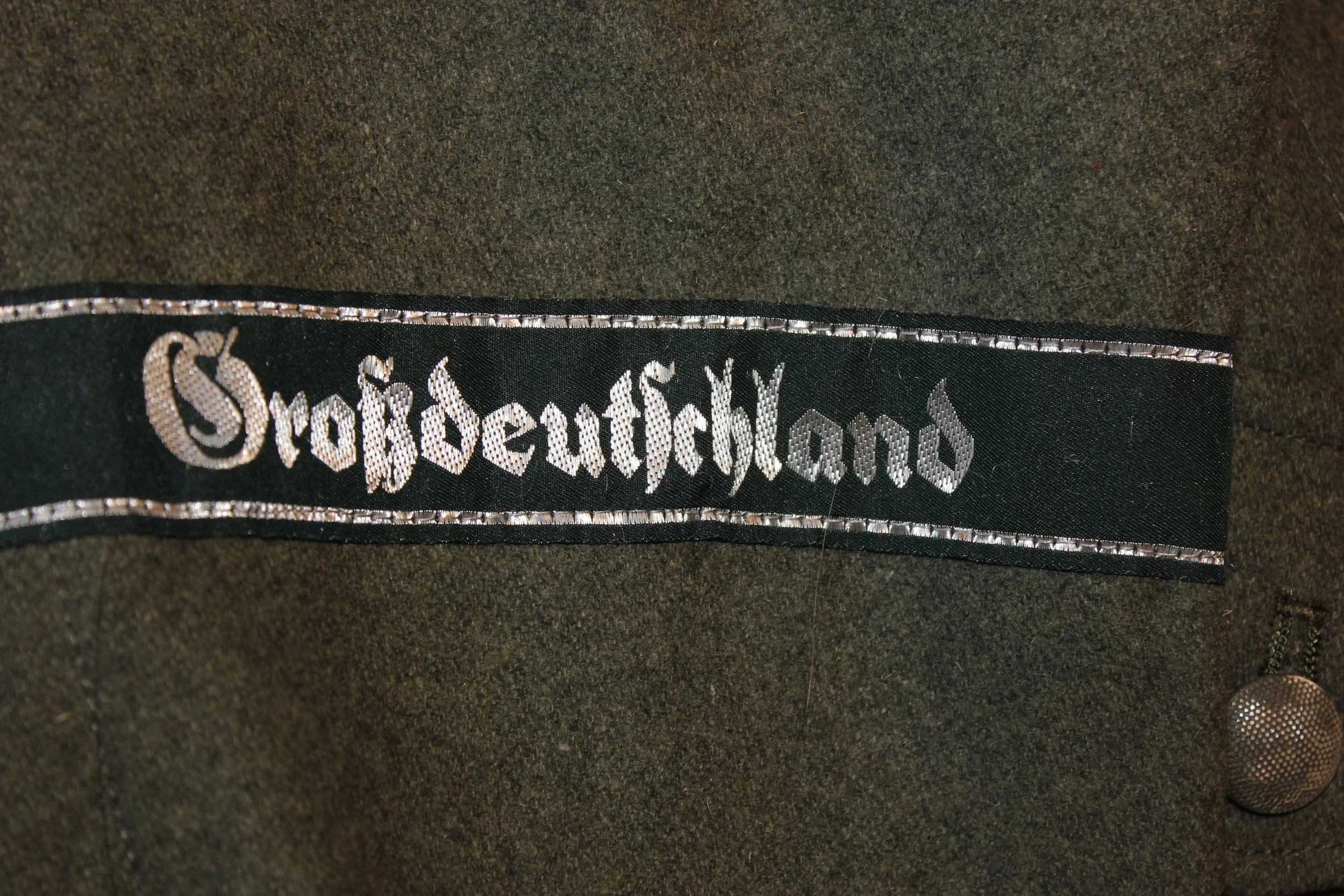





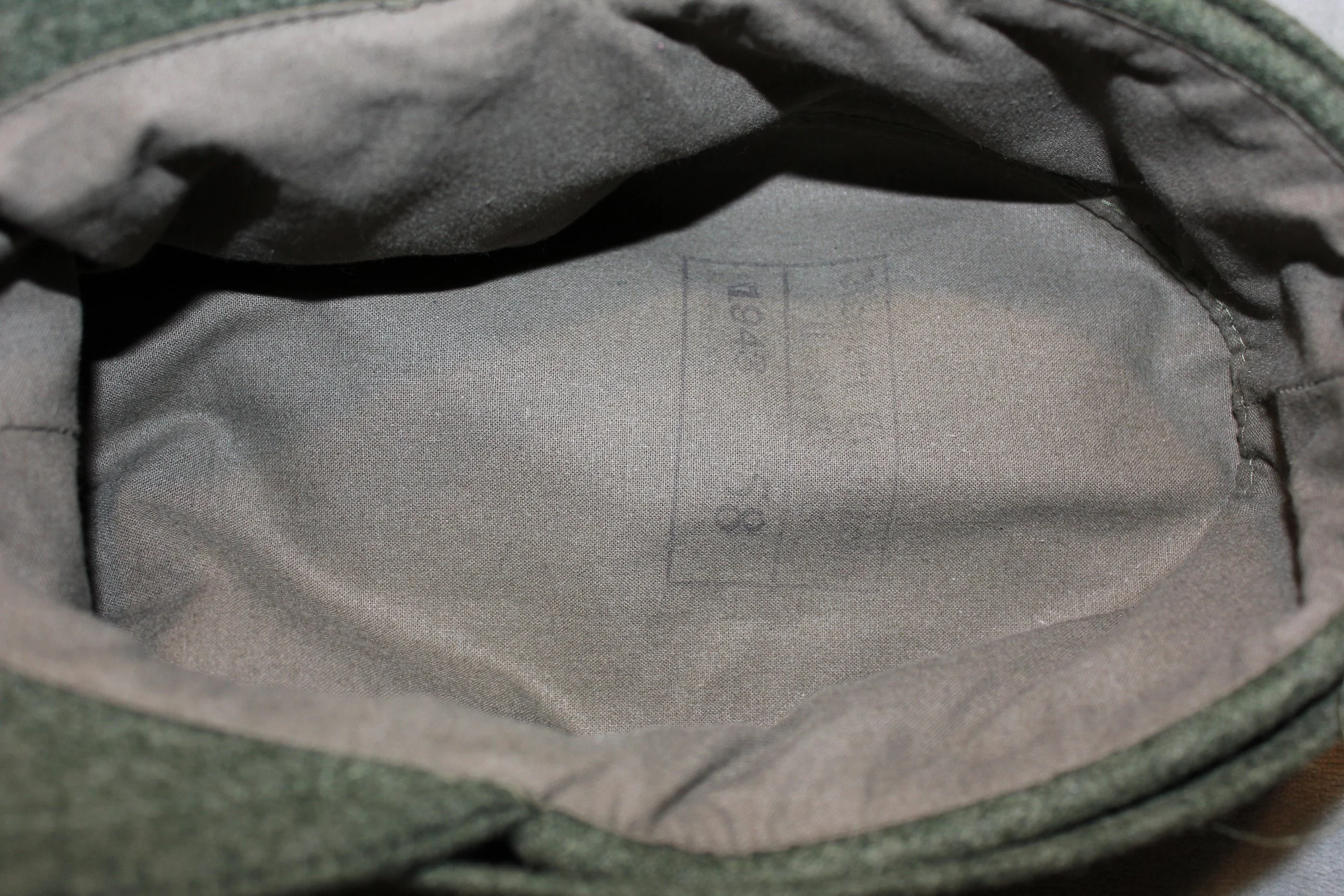



























![fa54c3dc8ffef79d2e5c5c90b9297828--german-soldier-german-army[1].jpg](https://images.squarespace-cdn.com/content/v1/61355b53c1baef12641a2de9/1699743587578-JX8BYV5K7ZDNVMP40C7O/fa54c3dc8ffef79d2e5c5c90b9297828--german-soldier-german-army%5B1%5D.jpg)





































